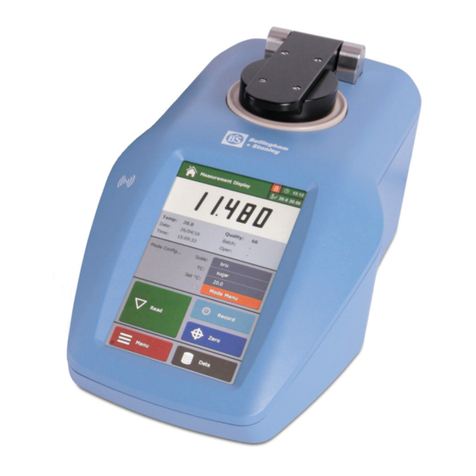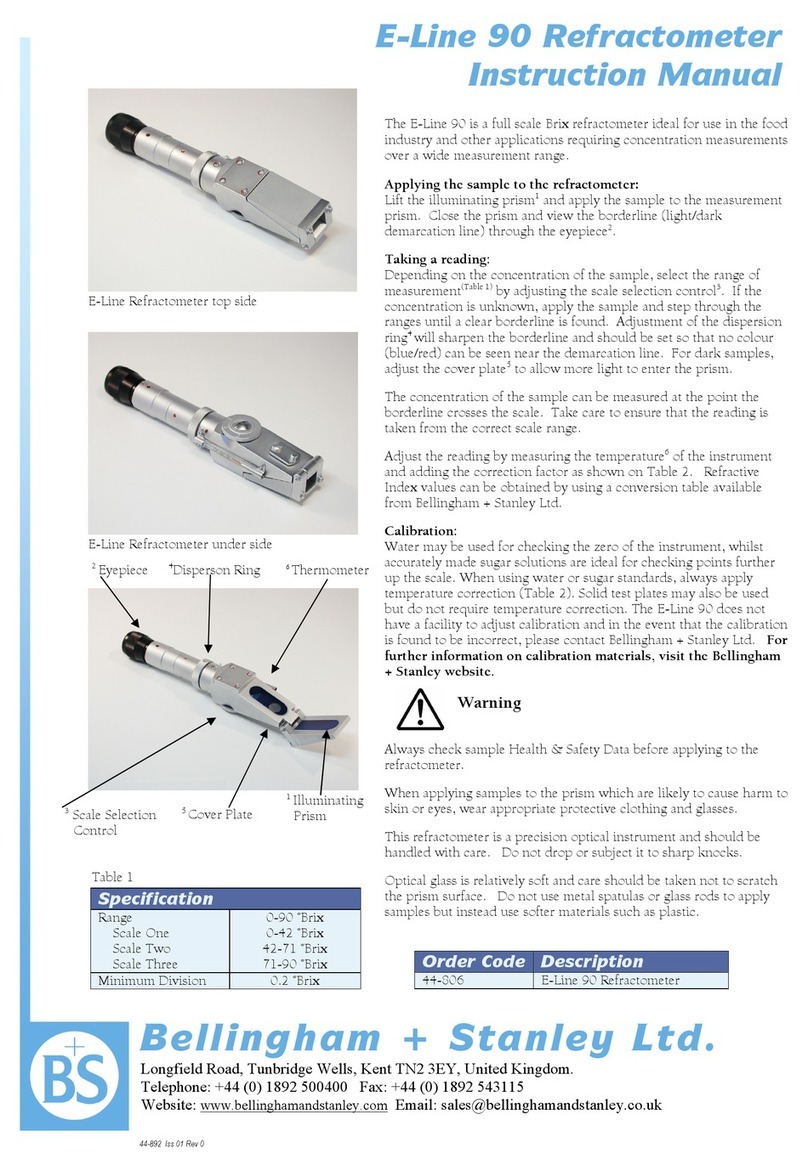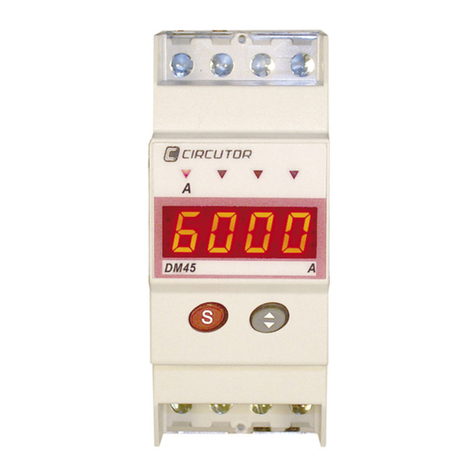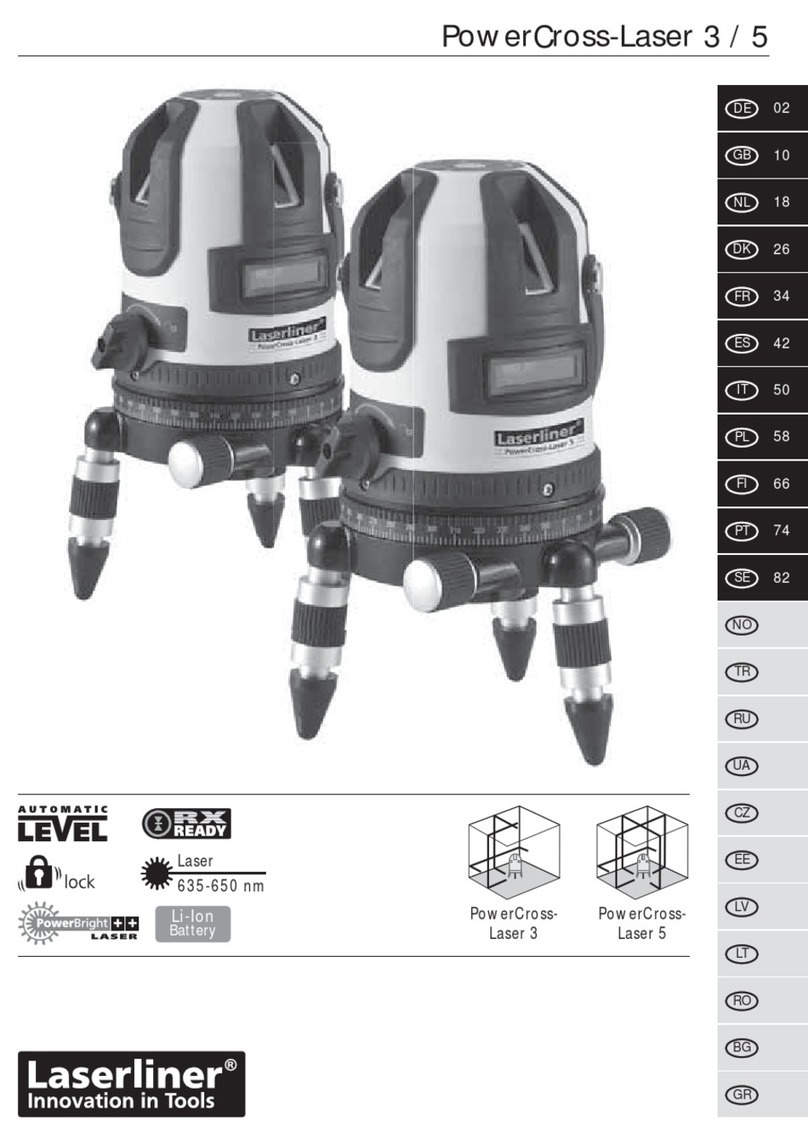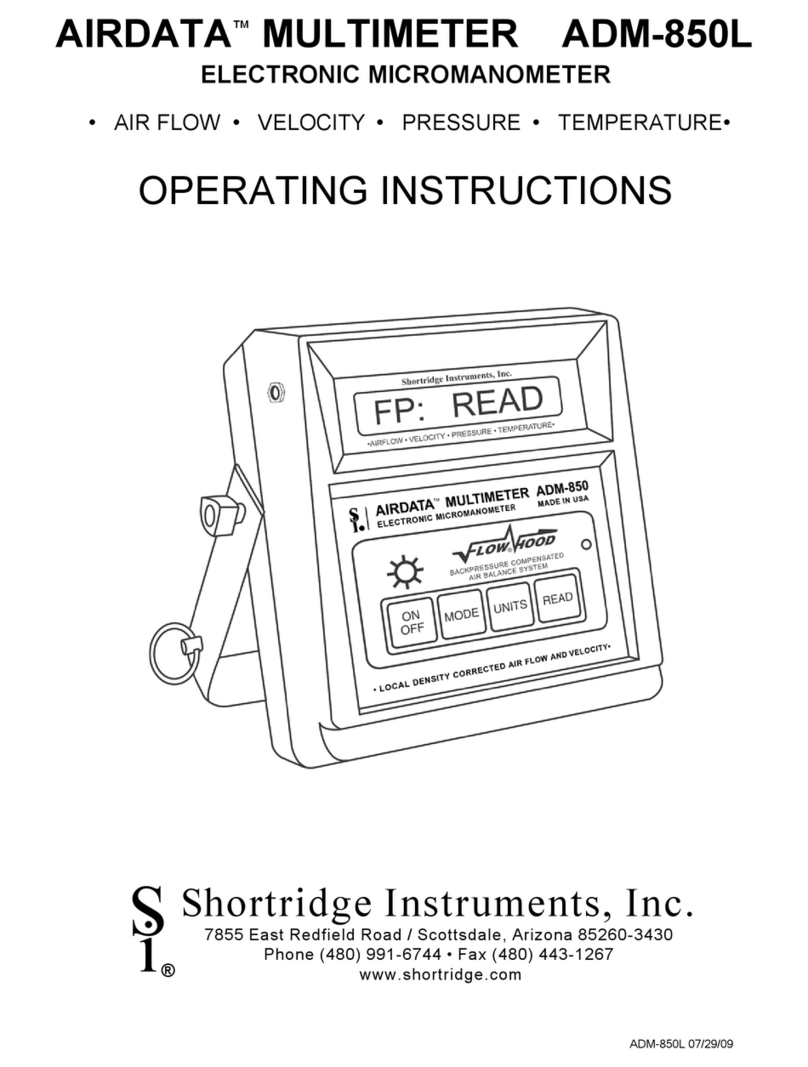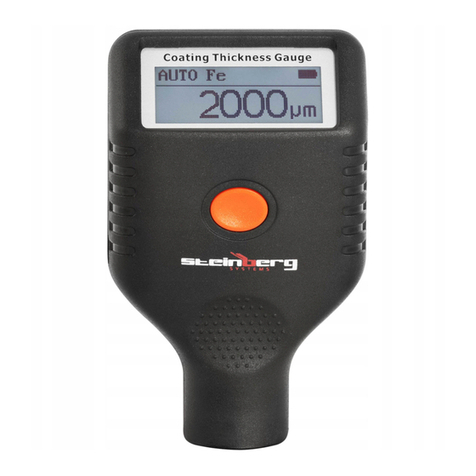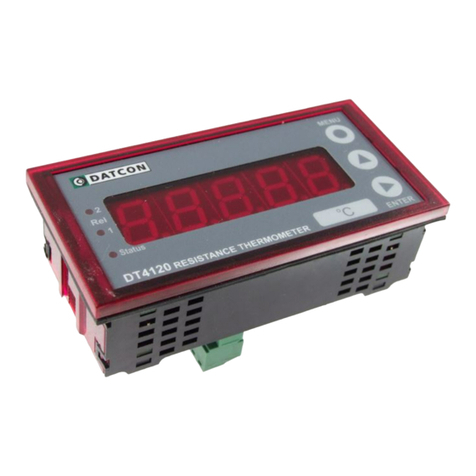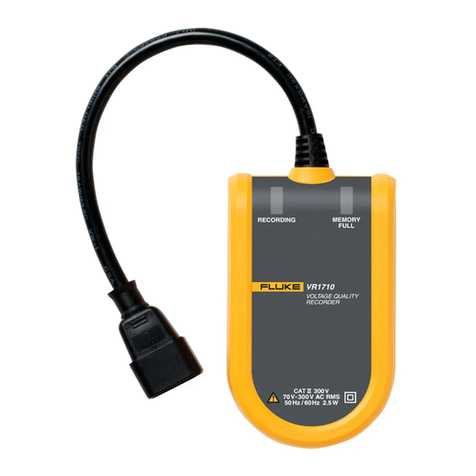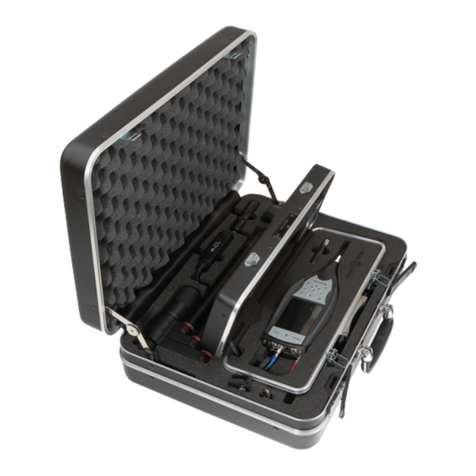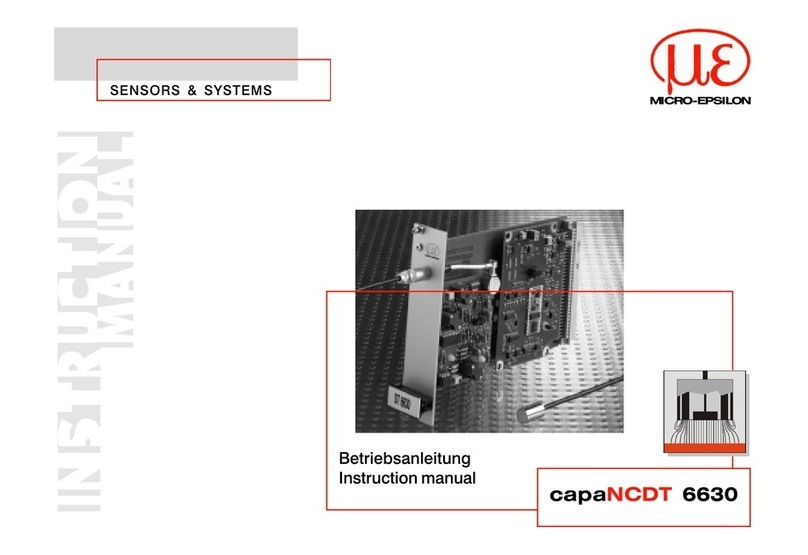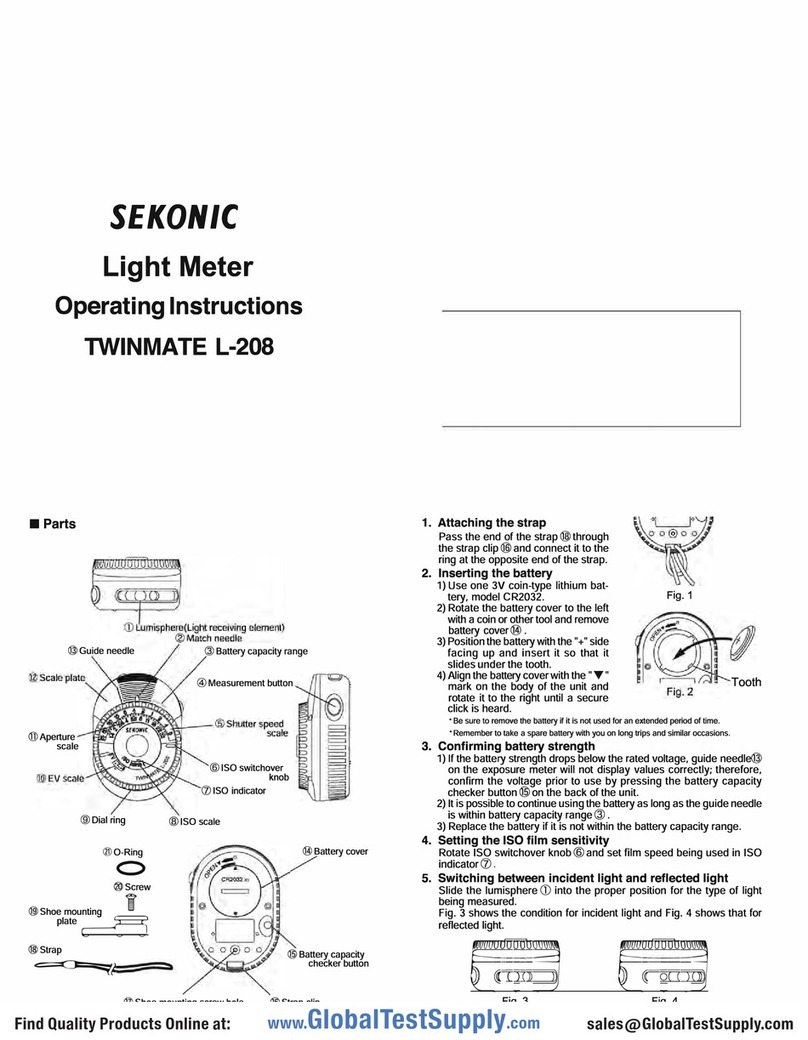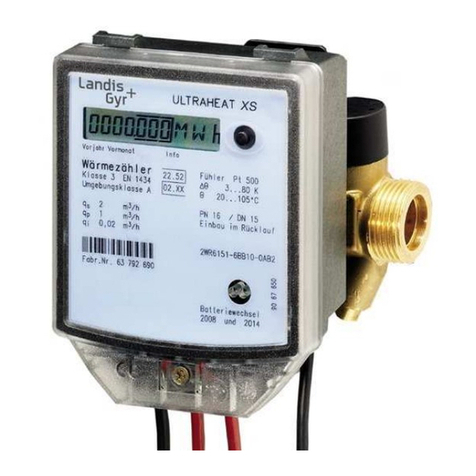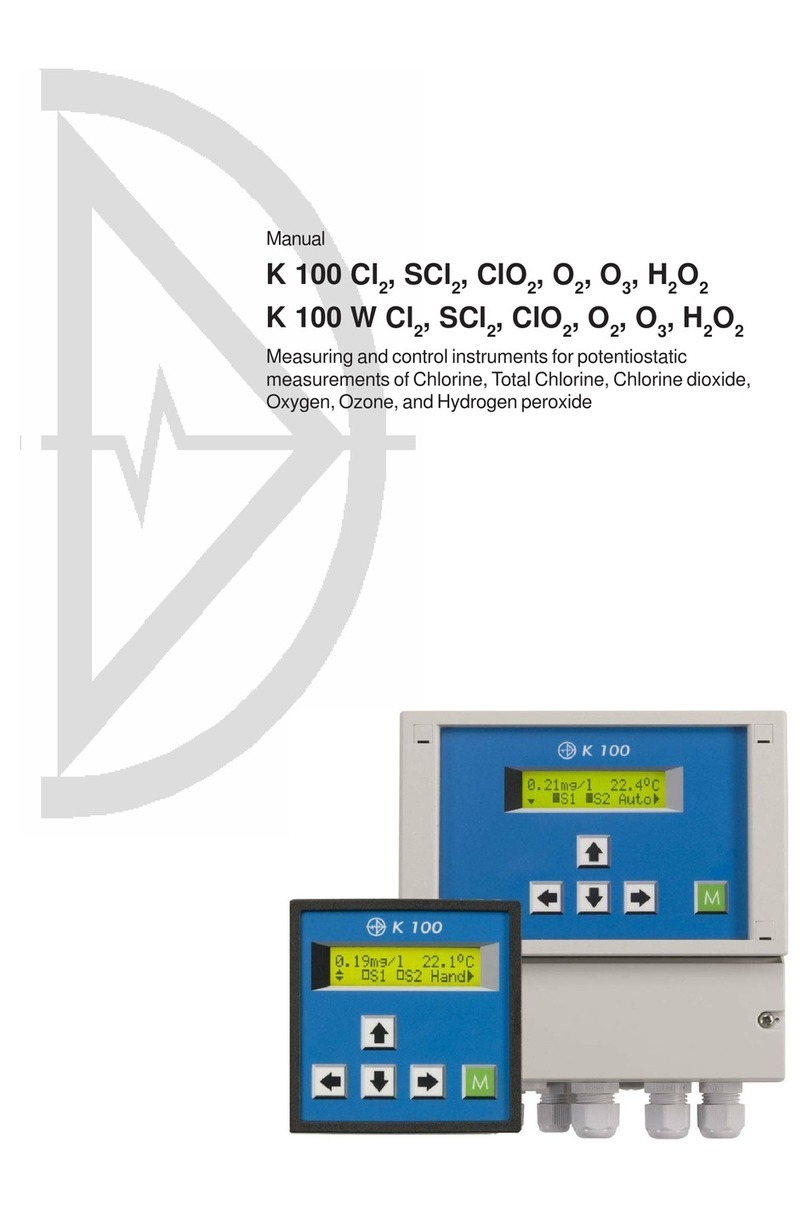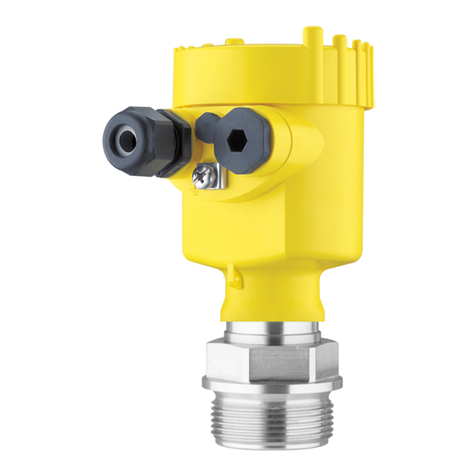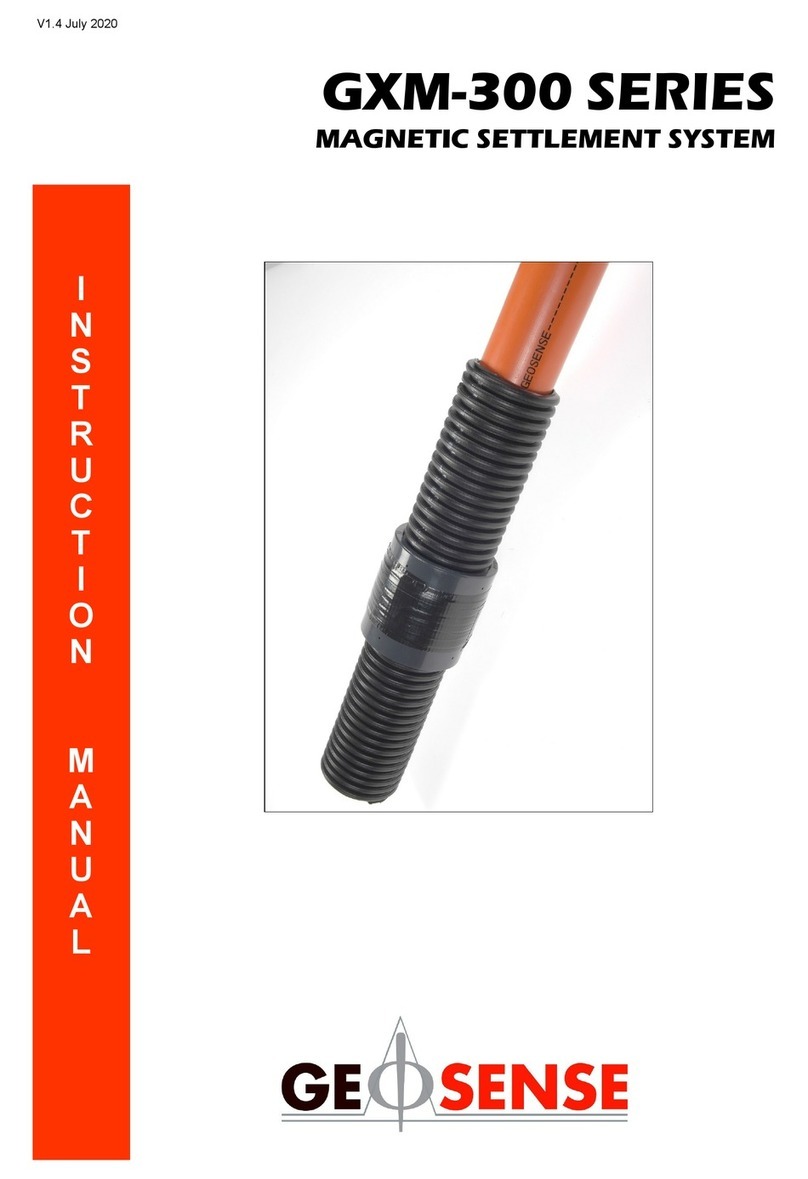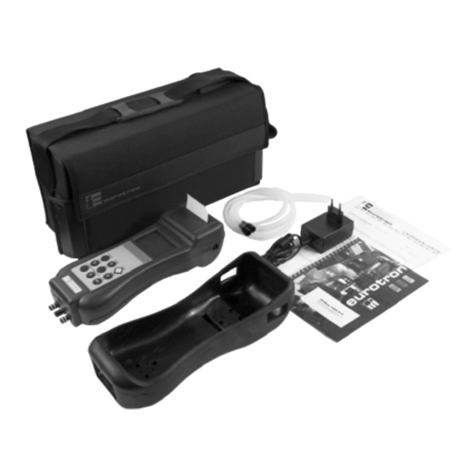Bellingham + Stanley Ltd. E-Line User manual

Refractive Index is one of the most important optical parameters used to
identify and authenticate polished precious and semi-precious gemstones. The
E-Line Gemological refractometer is a low cost, lightweight measuring
instrument used by jewellers and traders of gemstones. The Gemological
refractometer can also be used to identify whether a particular stone is
Isotropic or Anistropic (uniaxial or biaxial).
Method of Operation (Singly Refractive)
1. Place the instrument on a suitable table. Open the upper cover. Drop a
few drops of contact liquid (see table over page) onto the surface of the
prism using a thin glass bar or soft wooden stick. (
CAUTION:
Contact
Liquid - Read Material Safety Data Sheet
).
2. Gently place the polished surface of gemstone on the prism, depressing it
lightly to make sure contact liquid is distributed evenly between the
gemstone and measuring prism.
3. Close the upper cover.
4. Place the light source in the light entrance socket of refractometer.
5. Look through the eyepiece and by a push/pull action; focus so that the
light/dark demarcation line can be seen in the field of view against the
refractive index scale.
6. Read the refractive index of the gemstone from the scale where the
demarcation line crosses the refractive index scale.
Anistropic Gemstones (Doubly Refractive)
Anistropic gemstones will display two demarcation lines when viewed through
the eyepiece. These stones are sometimes known as ‘bi-fringent’ or ‘doubly
refractive.’ There are two types of Anistropic gemstones: (1) uniaxial, which
has a single optical axis that does not cause light to doubly refract, and (2)
biaxial, which has two optical axes that do not cause the light to doubly
refract.
It is possible to identify whether a stone is uniaxial or biaxial by using the
polaiser6and/or by rotating the gemstone through steps of 90°, taking
refractive index measurements and monitoring the movement or prominence
of the demarcation lines. Simple differentiation between uniaxial gemstones
and biaxial gemstones can easily be achieved by rotating either the polariser or
gemstone, where one demarcation line will remain static (uniaxial) as opposed
to both demarcation lines varying in position (biaxial). More complex
determination can be achieved by measuring the angle of double refraction as
detailed below:
Using the polariser to identify Anistropic Gemstones
1. Place the gemstone on the refractometer following the steps above.
2. Place the polariser on the eyepiece.
3. Turn the polariser in the eyepiece until a single borderline is seen (light is
vibrating in one direction only, eliminating the extra-ordinary rays caused
by birefringence).
4. Read the refractive index.
5. Gently rotate the gemstone on the prism by 90° taking care not to scratch
the prism.
6. Turn the polariser by 90°
7. Measure the refractive index of the light vibrating at 90° to the
measurement in point 4.
8. Repeat steps 5 to 7 until the stone has passed through 180°
Interpretation of the results will identify the value of double refraction by
calculating the difference between the measurement group with the maximum
refractive index and the measurement group with the lowest refractive index
and comparing to known data.
B
ellingham + Stanley Ltd.
Longfield Road, Tunbridge Wells, Kent TN2 3EY, United Kingdom.
Telephone: +44 (0) 1892 500400 Fax: +44 (0) 1892 543115
Website: www.bellinghamandstanley.com Email: sales@bellinghamandstanley.co.uk
Specification
Measuring range 1.30-1.81
Minimum graduation value 0.01
Size 30x70x130mm
Weight 400g
Order Code Description
44-861
E-Line Gemological
Refractometer
E-Line Gemological Refractometer
Instruction Manual
44-895 Iss 01 Rev 0
Gemological Refractometer
Eyepiece Bod
y
Filter
Polariser
Upper
Cover
Prism Light Entrance
Socket
Torch

B
ellingham + Stanley Ltd.
Longfield Road, Tunbridge Wells, Kent TN2 3EY, United Kingdom.
Telephone: +44 (0) 1892 500400 Fax: +44 (0) 1892 543115
Website: www.bellinghamandstanley.com Email: sales@bellinghamandstanley.co.uk
E-Line Gemological Refractometer
Instruction Manual
44-89
5
Iss 01 Rev
0
Calibration Verification:
The refractometer can be checked for accuracy by placing the calibration block on the prism and verifying the readings against the declared
value inscribed on the block. To apply the block, follow the ‘Method of Operation for Singly Refractive Gemstones’. The refractometer can
not be physically adjusted but any error between the calibration block and readings can be used as a correction factor for gemstone
measurement.
Attention and Maintenance
The instrument is a delicate scientific instrument and should be treated accordingly. It has no user serviceable parts. After use, the
instrument should be placed in its carry case and stored in a dry place. Remove battery from light source (torch) after use to prevent acid
leakage on to the instrument. Take care with contact liquids
(CAUTION: Contact Liquid – Read Material Safety Data Sheet)
.
Contact Liquids
Contact liquids are required to expel air between the measuring prism and gemstone under test. The contact liquid must be of a higher
refractive index value than the gemstone under test; otherwise the refractive index of the contact liquid will be read. Contact liquids may be
extremely harmful if not handled correctly – make sure that the guidelines for the liquids are followed carefully and read the Health &
Safety data supplied (also available from the Technical Centre which forms part of B+S website at www.bellinghamandstanley.com.
Contact liquids are available from Bellingham+Stanley as listed below:
Order Code Description Refractive Index Value (RI)
10-43 Monobromonapthelene (6ml) 1.65
10-61 Methyl Iodide (3ml) 1.74
10-62 Sulphated methyliodide (10ml) 1.79
Typical Refractive Index values of Gemstones
Agate 1.544 - 1.553
Alexandrite 1.746 - 1.755
Almandine 1.75 - 1.83
Amber 1.539 - 1.545
Amethyst 1.532 - 1.554
Ammolite 1.52 -1.68
Andalusite 1.629 - 1.650
Apatite 1.632 - 1.42
Aquamarine 1.567-1.590
Axenite 1.674 - 1.704
Beryl 1.57 - 1.60
Beryl, Red 1.570 - 1.598
Chalcedony 1.544 - 1.553
Chrome Tourmaline, 1.61 - 1.64
Citrine 1.532 - 1.554
Clinohumite 1.625 - 1.675
Coral 1.486 - 1.658
Crystal 2.000
Crysoberyl, Catseye 1.746 - 1.755
Danburite 1.627 - 1.641
Diamond 2.417
Emerald 1.560 - 1.605
Emerald Catseye 1.560 - 1.605
Flourite 1.434
Garnet, Grossular 1.72 - 1.80
Garnet, Andradite 1.88 - 1.94
Garnet, Demantiod 1.880 - 1.9
Garnet, Mandarin 1.790 - 1.8
Garnet, Pyrope 1.73 - 1.76
Garnet, Rhodolite 1.740 - 1.770
Garnet, Tsavorite 1.739 - 1.744
Garnet, Uvarovite 1.74 - 1.87
Hauyn 1.490 - 1.505
Iolite 1.522 - 1.578
Jade, Jadeite 1.64 - 1.667
Jade, Nephrite 1.600 - 1.641
Jet 1.660
Kunzite 1.660 - 1.676
Labradorite 1.560 - 1.572
Lapis Lazuli 1.50 - 1.55
Moonstone 1.518 - 1.526
Morganite 1.585 - 1.594
Obsidian 1.50
Opal, Black 1.440 - 1.460
Opal, Fire 1.430 - 1.460
Opal, White 1.440 - 1.460
Oregon Sunstone 1.560 - 1.572
Padparadja 1.760 - 1.773
Pearl 1.53 - 1.69
Peridot 1.635 - 1.690
Quartz 1.544 - 1.553
Ruby 1.757 - 1.779
Sapphire 1.757 - 1.779
Sapphire, Star 1.760 - 1.773
Spessarite 1.79 - 1.81
Spinel 1.712 - 1.717
Spinel, Blue 1.712 - 1.747
Spinel, Red 1.708 - 1.735
Star Ruby 1.76 - 1.773
Tanzanite 1.690-1.7
Tanzanite 1.692 - 1.700
Topaz 1.607 - 1.627
Topaz, Imperial 1.605-1.640
Tourmaline 1.603 - 1.655
Tourmaline, Blue 1.61 - 1.64
Tourmaline, Catseye 1.61 - 1.64
Tourmaline, Green 1.61 - 1.64
Tourmaline, Paraiba 1.61 - 1.65
Tourmaline, Red 1.61 - 1.64
Zircon 1.777 - 1.987
Zirconia, Cubic 2.173 - 2.21
The above table is a guide only. Bellingham+Stanley Ltd. do not take any responsibility due to loss or damage caused by use of data
contained in this instruction manual.
Table of contents
Other Bellingham + Stanley Ltd. Measuring Instrument manuals
